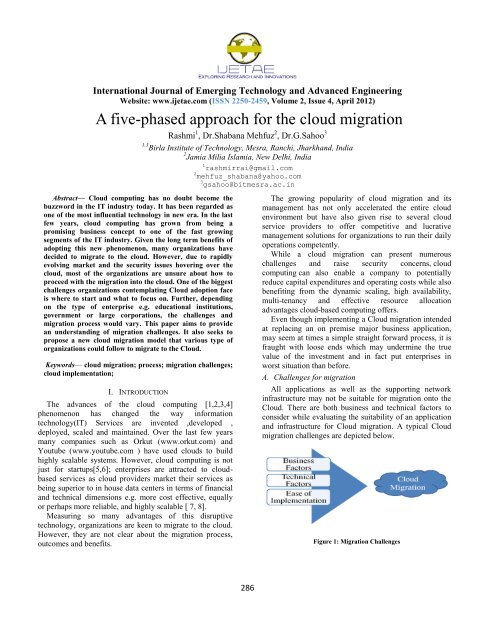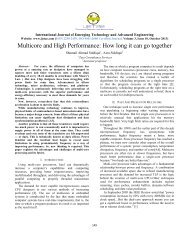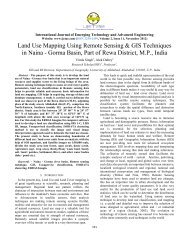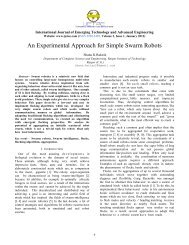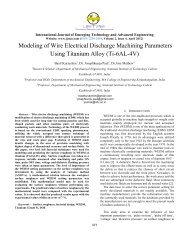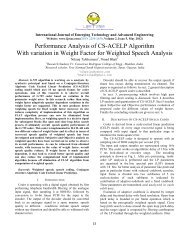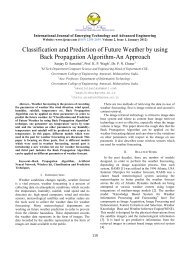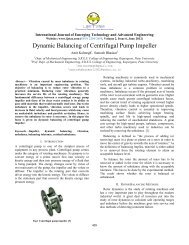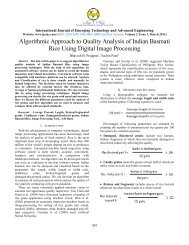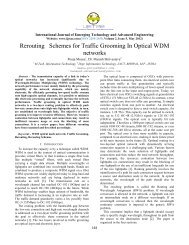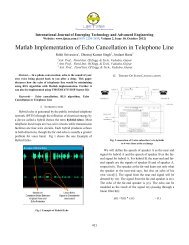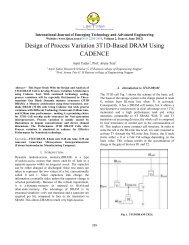A five-phased approach for the cloud migration - IJETAE
A five-phased approach for the cloud migration - IJETAE
A five-phased approach for the cloud migration - IJETAE
You also want an ePaper? Increase the reach of your titles
YUMPU automatically turns print PDFs into web optimized ePapers that Google loves.
International Journal of Emerging Technology and Advanced Engineering<br />
Website: www.ijetae.com (ISSN 2250-2459, Volume 2, Issue 4, April 2012)<br />
A <strong>five</strong>-<strong>phased</strong> <strong>approach</strong> <strong>for</strong> <strong>the</strong> <strong>cloud</strong> <strong>migration</strong><br />
Rashmi 1 , Dr.Shabana Mehfuz 2 , Dr.G.Sahoo 3<br />
Abstract— Cloud computing has no doubt become <strong>the</strong><br />
buzzword in <strong>the</strong> IT industry today. It has been regarded as<br />
one of <strong>the</strong> most influential technology in new era. In <strong>the</strong> last<br />
few years, <strong>cloud</strong> computing has grown from being a<br />
promising business concept to one of <strong>the</strong> fast growing<br />
segments of <strong>the</strong> IT industry. Given <strong>the</strong> long term benefits of<br />
adopting this new phenomenon, many organizations have<br />
decided to migrate to <strong>the</strong> <strong>cloud</strong>. However, due to rapidly<br />
evolving market and <strong>the</strong> security issues hovering over <strong>the</strong><br />
<strong>cloud</strong>, most of <strong>the</strong> organizations are unsure about how to<br />
proceed with <strong>the</strong> <strong>migration</strong> into <strong>the</strong> <strong>cloud</strong>. One of <strong>the</strong> biggest<br />
challenges organizations contemplating Cloud adoption face<br />
is where to start and what to focus on. Fur<strong>the</strong>r, depending<br />
on <strong>the</strong> type of enterprise e.g. educational institutions,<br />
government or large corporations, <strong>the</strong> challenges and<br />
<strong>migration</strong> process would vary. This paper aims to provide<br />
an understanding of <strong>migration</strong> challenges. It also seeks to<br />
propose a new <strong>cloud</strong> <strong>migration</strong> model that various type of<br />
organizations could follow to migrate to <strong>the</strong> Cloud.<br />
Keywords— <strong>cloud</strong> <strong>migration</strong>; process; <strong>migration</strong> challenges;<br />
<strong>cloud</strong> implementation;<br />
I. INTRODUCTION<br />
The advances of <strong>the</strong> <strong>cloud</strong> computing [1,2,3,4]<br />
phenomenon has changed <strong>the</strong> way in<strong>for</strong>mation<br />
technology(IT) Services are invented ,developed ,<br />
deployed, scaled and maintained. Over <strong>the</strong> last few years<br />
many companies such as Orkut (www.orkut.com) and<br />
Youtube (www.youtube.com ) have used <strong>cloud</strong>s to build<br />
highly scalable systems. However, <strong>cloud</strong> computing is not<br />
just <strong>for</strong> startups[5,6]; enterprises are attracted to <strong>cloud</strong>based<br />
services as <strong>cloud</strong> providers market <strong>the</strong>ir services as<br />
being superior to in house data centers in terms of financial<br />
and technical dimensions e.g. more cost effective, equally<br />
or perhaps more reliable, and highly scalable [ 7, 8].<br />
Measuring so many advantages of this disruptive<br />
technology, organizations are keen to migrate to <strong>the</strong> <strong>cloud</strong>.<br />
However, <strong>the</strong>y are not clear about <strong>the</strong> <strong>migration</strong> process,<br />
outcomes and benefits.<br />
1,3 Birla Institute of Technology, Mesra, Ranchi, Jharkhand, India<br />
2 Jamia Milia Islamia, New Delhi, India<br />
1 rashmirrai@gmail.com<br />
2 mehfuz_shabana@yahoo.com<br />
3 gsahoo@bitmesra.ac.in<br />
286<br />
The growing popularity of <strong>cloud</strong> <strong>migration</strong> and its<br />
management has not only accelerated <strong>the</strong> entire <strong>cloud</strong><br />
environment but have also given rise to several <strong>cloud</strong><br />
service providers to offer competitive and lucrative<br />
management solutions <strong>for</strong> organizations to run <strong>the</strong>ir daily<br />
operations competently.<br />
While a <strong>cloud</strong> <strong>migration</strong> can present numerous<br />
challenges and raise security concerns, <strong>cloud</strong><br />
computing can also enable a company to potentially<br />
reduce capital expenditures and operating costs while also<br />
benefiting from <strong>the</strong> dynamic scaling, high availability,<br />
multi-tenancy and effective resource allocation<br />
advantages <strong>cloud</strong>-based computing offers.<br />
Even though implementing a Cloud <strong>migration</strong> intended<br />
at replacing an on premise major business application,<br />
may seem at times a simple straight <strong>for</strong>ward process, it is<br />
fraught with loose ends which may undermine <strong>the</strong> true<br />
value of <strong>the</strong> investment and in fact put enterprises in<br />
worst situation than be<strong>for</strong>e.<br />
A. Challenges <strong>for</strong> <strong>migration</strong><br />
All applications as well as <strong>the</strong> supporting network<br />
infrastructure may not be suitable <strong>for</strong> <strong>migration</strong> onto <strong>the</strong><br />
Cloud. There are both business and technical factors to<br />
consider while evaluating <strong>the</strong> suitability of an application<br />
and infrastructure <strong>for</strong> Cloud <strong>migration</strong>. A typical Cloud<br />
<strong>migration</strong> challenges are depicted below.<br />
Figure 1: Migration Challenges
International Journal of Emerging Technology and Advanced Engineering<br />
Website: www.ijetae.com (ISSN 2250-2459, Volume 2, Issue 4, April 2012)<br />
1) Business Factors<br />
The key business factors to consider when moving to<br />
<strong>the</strong> Cloud are as depicted below:<br />
Existing investments in IT: Small and Medium<br />
Enterprises (SMEs) are definitely at an advantage over<br />
large organizations when it comes to Cloud <strong>migration</strong>.<br />
Due to a considerably limited installed IT base, SMEs<br />
may be able to directly move into <strong>the</strong> Cloud. Most<br />
large corporations, however, have already made<br />
significant investments in <strong>the</strong>ir IT infrastructure. Huge<br />
investments and complexity of hardware, network,<br />
application support, administration, customization and<br />
integration would make it difficult <strong>for</strong> <strong>the</strong>m to move<br />
away from <strong>the</strong>ir existing IT environment.<br />
Costs: The existing cost model <strong>for</strong> IT is a combination<br />
of capital expenditure and operational expenditure.<br />
Organizations generally budget <strong>for</strong> peak loads<br />
incurring higher capital expenditure. However, <strong>the</strong>se<br />
costs while being high are budgeted and predictable.<br />
Moving to an operational cost model through <strong>the</strong><br />
adoption of <strong>the</strong> Cloud would mean paying <strong>for</strong><br />
resources as per usage. This model implies<br />
unpredictable operational costs especially <strong>for</strong> those<br />
applications with varying demand <strong>for</strong> e.g. public<br />
facing websites. There<strong>for</strong>e, it is important <strong>for</strong><br />
organizations to estimate application usage and<br />
operational costs be<strong>for</strong>e moving to <strong>the</strong> Cloud. Fur<strong>the</strong>r,<br />
<strong>migration</strong> costs need to be understood and factored in<br />
be<strong>for</strong>e making <strong>the</strong> decision to move into <strong>the</strong> Cloud.<br />
Failure to do this could negate <strong>the</strong> cost savings that are<br />
sought to be derived from <strong>the</strong> adoption of <strong>the</strong> Cloud.<br />
Data security: Security of data is a key concern while<br />
considering <strong>the</strong> move to <strong>the</strong> Cloud. Applications that<br />
have very sensitive and confidential in<strong>for</strong>mation<br />
would be better off being behind <strong>the</strong> corporate<br />
firewall. Data with greater security tolerance however<br />
could be ported onto <strong>the</strong> Cloud. Technical<br />
mechanisms <strong>for</strong> data security in <strong>the</strong> Cloud are still<br />
evolving and security of data is still <strong>the</strong> top most<br />
inhibiter of Cloud adoption [10].<br />
Regulations: Geopolitical issues especially <strong>for</strong><br />
Governments and financial institutions should be<br />
carefully evaluated be<strong>for</strong>e making <strong>the</strong> transition to <strong>the</strong><br />
Cloud. In <strong>the</strong> Indian context this is especially relevant<br />
as most Cloud data centres are not located within <strong>the</strong><br />
country. It is also important to ensure that local<br />
regulations relevant to each organization should be<br />
adhered to be<strong>for</strong>e deciding to move to <strong>the</strong> Cloud [11].<br />
287<br />
Provisioning: One of <strong>the</strong> key benefits of <strong>the</strong> Cloud is<br />
<strong>the</strong> quick provisioning of resources. Applications that<br />
need to be quickly available and scaled up rapidly<br />
based on demand are ideal candidates <strong>for</strong> <strong>the</strong> Cloud.<br />
Most organizations have business requirements that<br />
need to be supported by quick provisioning of IT data,<br />
e.g. an organization running a limited period online<br />
marketing campaign. Several applications are seasonal<br />
in nature as well <strong>for</strong> example HR and Payroll<br />
applications, which need resources to be processed<br />
only during certain periods. These sorts of<br />
applications can make use of <strong>the</strong> ability of <strong>the</strong> Cloud<br />
to quickly provision resources.<br />
2) Technical Factors<br />
Some of <strong>the</strong> key technical aspects to be considered are:<br />
Existing infrastructure: The traditional IT architecture<br />
is optimized to cater to <strong>the</strong> current demand in <strong>the</strong><br />
sector. Moving to <strong>the</strong> Cloud would necessitate a<br />
change in <strong>the</strong> IT architecture. With applications<br />
moving into <strong>the</strong> Cloud, <strong>the</strong> way IT is delivered to end<br />
users would undergo a radical change. Some end user<br />
support would be dependent on <strong>the</strong> Cloud service<br />
provider response. Hence, organizations would have<br />
to concentrate on building vendor management<br />
competencies [15].<br />
Security architecture: Application security and<br />
controls would need to change to adapt to <strong>the</strong> Cloud<br />
ecosystem. New types of mechanisms would be<br />
required to secure data in transit and at rest. Identity<br />
and access management mechanisms would need to be<br />
adapted to Cloud deployments. Fur<strong>the</strong>r, data<br />
encryption mechanisms and key management <strong>for</strong> <strong>the</strong><br />
Cloud are yet to mature [12].<br />
Complexity: Simple applications can be easily<br />
migrated to <strong>the</strong> Cloud and <strong>the</strong> amount of ef<strong>for</strong>t<br />
required to move such applications may not be not too<br />
significant. These applications can be directly<br />
migrated to Software as a Service [14] (SaaS)<br />
applications already available from various vendors.<br />
E.g. e-Mail applications can be directly ported onto<br />
Cloud offerings like Office365, Google Apps or Lotus<br />
Live. Similarly, moving a simple web server to an<br />
Infrastructure as Service [14] (IaaS) plat<strong>for</strong>m may not<br />
require as much ef<strong>for</strong>t. Migration of complex<br />
applications however, needs elaborate planning and<br />
testing prior to implementation. Legacy applications<br />
and existing enterprise applications could require code<br />
changes to work on <strong>the</strong> Cloud.
International Journal of Emerging Technology and Advanced Engineering<br />
Website: www.ijetae.com (ISSN 2250-2459, Volume 2, Issue 4, April 2012)<br />
Network and support: With applications moving to <strong>the</strong><br />
Cloud, <strong>the</strong>re is a real risk of <strong>the</strong> network becoming <strong>the</strong><br />
single point of failure. Fur<strong>the</strong>r, due to a large number<br />
of connections to <strong>the</strong> external Cloud, <strong>the</strong> bandwidth<br />
may need to be upgraded. Hence, organizations would<br />
need to plan <strong>for</strong> better and reliable network<br />
connections to <strong>the</strong> Cloud. This could mean that<br />
organizations may incur higher costs <strong>for</strong> additional<br />
and higher capacity network connections. Fur<strong>the</strong>r, a<br />
higher level of support would be required of telecom<br />
providers to ensure that any downtime is minimized<br />
[13].<br />
IT skills: Although <strong>the</strong> Cloud is based on existing<br />
technologies, it would require updated skills within<br />
<strong>the</strong> IT team, especially on architecture,<br />
implementation, develop and operation. For<br />
organizations not yet exposed to newer IT<br />
technologies like virtualization, Web 2.0 etc. <strong>the</strong><br />
learning curve would be sharper. Fur<strong>the</strong>r, <strong>migration</strong> of<br />
applications to <strong>the</strong> Cloud is perceived by IT teams as a<br />
loss of control. These types of cultural challenges<br />
would need to be addressed prior to deciding <strong>the</strong><br />
<strong>migration</strong> to <strong>the</strong> Cloud [15].<br />
Service Level Agreements (SLAs): Ano<strong>the</strong>r key aspect<br />
to consider be<strong>for</strong>e migrating to <strong>the</strong> Cloud is whe<strong>the</strong>r<br />
Cloud service providers are able to provide SLAs that<br />
<strong>the</strong> business needs. This is quite essential considering<br />
<strong>the</strong> limited control organizations have over<br />
applications on <strong>the</strong> Cloud. SLAs need to address <strong>the</strong><br />
concerns of availability, confidentiality and integrity<br />
of <strong>the</strong> application. Fur<strong>the</strong>r, it should clearly outline<br />
service provider responsibilities and penalties <strong>for</strong><br />
failure to meet agreed service levels [11].<br />
B. Related work<br />
Cloud computing is not just about technology; it also<br />
represents <strong>the</strong> fundamental change in how IT is<br />
provisioned and used. Be<strong>for</strong>e adopting <strong>the</strong> <strong>cloud</strong><br />
computing; enterprises have to consider its benefits, risks<br />
and effects on <strong>the</strong>ir organisation [13]. The work by<br />
Khajeh-Hosseini et al. [16] illustrates <strong>the</strong> potential<br />
benefits and risks associated with <strong>the</strong> <strong>migration</strong> of an IT<br />
system in <strong>the</strong> oil & gas industry from an in-house data<br />
centre to Amazon EC2 from a broad variety of<br />
stakeholder perspectives across <strong>the</strong> enterprise, thus<br />
transcending <strong>the</strong> typical, yet narrow, financial and<br />
technical analysis. This work clearly states <strong>the</strong> need <strong>for</strong> a<br />
proper <strong>migration</strong> process.<br />
288<br />
Klems et al. [17] presented as a framework that could<br />
be used to compare <strong>the</strong> costs of using <strong>cloud</strong> computing<br />
with more conventional <strong>approach</strong>es, such as using in<br />
house IT infrastructure. Their framework was very briefly<br />
evaluated using two case studies. However, no results<br />
were provided because <strong>the</strong> framework was at an early<br />
developmental stage and more conceptual than concrete.<br />
Ano<strong>the</strong>r methodology and tools <strong>for</strong> model-driven<br />
<strong>migration</strong> of legacy applications to a service-oriented<br />
architecture with deployment in <strong>the</strong> <strong>cloud</strong>; i.e. <strong>the</strong> Service<br />
Cloud paradigm was presented by P. Mohagheghi et al.<br />
[18]. The <strong>migration</strong> <strong>approach</strong> used here is <strong>the</strong><br />
Architecture Driven Modernization (ADM) [19] by<br />
OMG. In this concept, modernization starts with <strong>the</strong><br />
extraction of <strong>the</strong> architecture of <strong>the</strong> legacy application<br />
(<strong>the</strong> ―Recover‖ activity). Having <strong>the</strong> architectural model<br />
helps to analyze <strong>the</strong> legacy system, identify <strong>the</strong> best ways<br />
<strong>for</strong> modernization and benefit from Model-Driven<br />
Engineering (MDE) technologies <strong>for</strong> generation of <strong>the</strong><br />
new system. This in<strong>for</strong>mation will be <strong>the</strong>n translated into<br />
models covering different aspects of <strong>the</strong> architecture:<br />
Business Process, Business Rules, Components,<br />
Implementation, and Test specifications. Though this<br />
process of <strong>migration</strong> is still a work in progress, it nowhere<br />
talks about <strong>the</strong> <strong>migration</strong> challenges and ways to handle<br />
<strong>the</strong>m.<br />
Ano<strong>the</strong>r <strong>approach</strong> by a group [20] at IBM talks about<br />
many automated tools <strong>for</strong> <strong>cloud</strong> <strong>migration</strong>, <strong>the</strong> challenges<br />
and <strong>the</strong> experiences. In <strong>the</strong>ir work <strong>the</strong>y have clearly stated<br />
<strong>the</strong> need <strong>for</strong> a smooth <strong>migration</strong> of workload from <strong>the</strong><br />
previous environment to <strong>the</strong> new <strong>cloud</strong> enabled<br />
environment in a cost effective way, with minimal<br />
disruption and risk. They have introduced extensions to<br />
an integrated automation capability that enables workload<br />
<strong>migration</strong> and discussed <strong>the</strong> impact that automated<br />
<strong>migration</strong> has on <strong>the</strong> cost and risks.<br />
All <strong>the</strong>se work clearly states <strong>the</strong> need <strong>for</strong> a well defined<br />
process <strong>for</strong> <strong>cloud</strong> <strong>migration</strong>. Though a lot has been talked<br />
about <strong>cloud</strong> computing; <strong>the</strong>re is significantly very less<br />
contribution on <strong>the</strong> process of <strong>migration</strong>. The model<br />
presented here <strong>for</strong> <strong>cloud</strong> <strong>migration</strong> is based on <strong>the</strong><br />
software engineering <strong>approach</strong> and attempt to present <strong>the</strong><br />
<strong>migration</strong> process along with feedback at each phase of<br />
<strong>migration</strong>.<br />
This model has not been discussed to any significant<br />
extent in <strong>the</strong> previously mentioned literature.
C. Contribution Summary<br />
International Journal of Emerging Technology and Advanced Engineering<br />
Website: www.ijetae.com (ISSN 2250-2459, Volume 2, Issue 4, April 2012)<br />
In this paper we have introduced a new waterfall model<br />
<strong>for</strong> <strong>cloud</strong> <strong>migration</strong>. This model is based on <strong>the</strong> Software<br />
Development Life Cycle model of software engineering.<br />
We have highlighted some of <strong>the</strong> challenges in <strong>cloud</strong><br />
<strong>migration</strong> process and various works done in <strong>the</strong> area of<br />
<strong>cloud</strong> <strong>migration</strong>. Section II describes <strong>the</strong> proposed model<br />
in detail, followed by section III which talks about <strong>the</strong><br />
considerations which must be taken by some common<br />
industry be<strong>for</strong>e migrating into <strong>cloud</strong>. Section IV covers<br />
<strong>the</strong> conclusion and future work.<br />
II. FIVE-PHASED WATERFALL MODEL<br />
The proposed waterfall model <strong>for</strong> <strong>cloud</strong> <strong>migration</strong> is<br />
based on <strong>the</strong> Iterative Waterfall model from Software<br />
Development Life Cycle (SDLC).The Iterative Waterfall<br />
model improves upon <strong>the</strong> Classical Water Fall model by<br />
including <strong>the</strong> feedback paths .In dynamic development<br />
environments, defects do get introduced in almost every<br />
phase of <strong>the</strong> life cycle. These defects usually get detected<br />
much later in <strong>the</strong> life cycle. Once a defect is detected, we<br />
need to go back to <strong>the</strong> phase where it got introduced and<br />
redo some of <strong>the</strong> work done during this phase and<br />
subsequent phases. When we talk about <strong>cloud</strong> <strong>migration</strong>,<br />
a similar scenario exists .The <strong>cloud</strong> <strong>migration</strong> would<br />
involve drawing up detailed project plans <strong>for</strong><br />
implementation, <strong>migration</strong> and deployment.<br />
Figure 2. Five-<strong>phased</strong> Model <strong>for</strong> Cloud Migration<br />
289<br />
It is one of <strong>the</strong> areas that require close attention due to<br />
<strong>the</strong> possibility of project overruns. IT team and vendors<br />
would need to work closely to enable quick <strong>migration</strong> to<br />
<strong>the</strong> Cloud and at <strong>the</strong> same time taking <strong>the</strong> feedback from<br />
each stages of <strong>the</strong> <strong>migration</strong> process and redo <strong>the</strong> work. In<br />
this paper, we have proposed a similar Waterfall Model<br />
<strong>for</strong> Cloud Migration. This model consists of <strong>five</strong> phases.<br />
Each phase of <strong>the</strong> proposed Water Fall model is described<br />
here in detail:<br />
Phase 1: Feasibility Study<br />
The key idea of feasibility study is to determine<br />
whe<strong>the</strong>r <strong>the</strong> <strong>cloud</strong> <strong>migration</strong> is financially and technically<br />
feasible. It would involve <strong>the</strong> analysis of <strong>the</strong> existing<br />
application and <strong>the</strong> collection of <strong>the</strong> data which would be<br />
input to <strong>the</strong> system, <strong>the</strong> processing required to be carried<br />
out on <strong>the</strong>se data, <strong>the</strong> output data required to be produced<br />
by <strong>the</strong> system, as well as study of various constraints on<br />
<strong>the</strong> behaviour of <strong>the</strong> system .A detail cost/benefit analysis<br />
is per<strong>for</strong>med and it may also be determined whe<strong>the</strong>r <strong>the</strong><br />
<strong>migration</strong> is not feasible due to high cost, resource<br />
constraints, or extraordinary technical reasons.<br />
Phase 2: Requirement Analysis & Planning<br />
In <strong>the</strong> planning phase, a detailed assessment is carried<br />
out of <strong>the</strong> existing IT environment with a view to<br />
understand <strong>the</strong> applications that are appropriate <strong>for</strong><br />
moving into <strong>the</strong> Cloud. The <strong>migration</strong> considerations<br />
mentioned earlier in this paper would be taken into<br />
account. Once candidate applications are identified <strong>for</strong><br />
<strong>migration</strong>, a detailed Return on Investment (ROI) and<br />
Total Cost of Ownership (TCO) assessment is carried out<br />
to understand <strong>the</strong> cost benefits that will be achieved from<br />
<strong>the</strong> <strong>migration</strong>.<br />
Phase 3: Migration<br />
In <strong>the</strong> <strong>migration</strong> phase, <strong>the</strong> applications selected will be<br />
ported to <strong>the</strong> Cloud and tested in a structured manner.<br />
Simple applications like e-Mail would just need testing<br />
prior to <strong>migration</strong> in terms of functionality and<br />
per<strong>for</strong>mance. However bespoke and/or complex<br />
applications would need <strong>the</strong> creation of a development<br />
and test environment. Procedures similar to those<br />
followed during Software<br />
Development Life Cycle (SDLC) would need to be<br />
adopted prior to deployment of <strong>the</strong> application on <strong>the</strong><br />
Cloud. Thereafter, validation of <strong>the</strong> new plat<strong>for</strong>m will be<br />
per<strong>for</strong>med through User Acceptance Testing (UAT) and<br />
signoff from business process owners.
International Journal of Emerging Technology and Advanced Engineering<br />
Website: www.ijetae.com (ISSN 2250-2459, Volume 2, Issue 4, April 2012)<br />
Phase 4: Testing and deployment (Go-Live)<br />
In <strong>the</strong> Go-live phase, <strong>the</strong> live production data will be<br />
ported onto <strong>the</strong> Cloud. This will be followed by post<strong>migration</strong><br />
testing and release. During this phase, a higher<br />
degree of monitoring and support is essential to handle<br />
any un<strong>for</strong>eseen issues. Some organizations may choose to<br />
adopt a parallel operation <strong>approach</strong> be<strong>for</strong>e fully moving to<br />
<strong>the</strong> migrated application.<br />
Phase 5: Monitoring & Maintenance<br />
A key requirement <strong>for</strong> Cloud <strong>migration</strong> is post<strong>migration</strong><br />
monitoring. Given <strong>the</strong> shared nature of <strong>the</strong><br />
Cloud, it is necessary to monitor Cloud application in<br />
terms of per<strong>for</strong>mance, availability and security. There are<br />
various monitoring tools being provided by Cloud<br />
vendors. These include Amazon Cloud Watch, Gomez,<br />
Hyperic CloudStatus etc. These tools can help IT teams<br />
detect breaks in SLAs and take <strong>the</strong> necessary corrective<br />
action<br />
III. ANALYSIS<br />
While a standard <strong>approach</strong> (depicted in figure 2) can be<br />
used <strong>for</strong> <strong>migration</strong> of applications to <strong>the</strong> Cloud, Cloud<br />
<strong>migration</strong> will vary depending on type of organization. To<br />
illustrate <strong>the</strong> difference, we have considered three types of<br />
organizations and analyzed <strong>the</strong>m <strong>for</strong> <strong>the</strong> proposed model.<br />
Large organizations<br />
As mentioned earlier, large organizations already have<br />
significant investments in IT. Fur<strong>the</strong>r, <strong>the</strong> IT environment<br />
tends to be much more mature and complex. For larger<br />
organizations to migrate to <strong>the</strong> Cloud, detailed<br />
assessments and planning would be required. Simple<br />
applications like e-Mail and collaboration solutions could<br />
be immediately moved to <strong>the</strong> Cloud to derive <strong>the</strong> benefits.<br />
However, it would be worthwhile <strong>for</strong> organizations to<br />
wait <strong>for</strong> complex Cloud-based applications such as ERPs<br />
to mature be<strong>for</strong>e migrating to <strong>the</strong>m. It would be beneficial<br />
<strong>for</strong> large organizations to draw up a roadmap <strong>for</strong> <strong>the</strong><br />
gradual adoption of <strong>the</strong> Cloud instead of following a big<br />
bang <strong>approach</strong>. This would enable <strong>the</strong>m to derive Cloud<br />
benefits over a period of time without having to write-off<br />
existing investments. A <strong>phased</strong> <strong>approach</strong> would also<br />
enable a graceful <strong>migration</strong> to <strong>the</strong> Cloud. Large<br />
organizations should never<strong>the</strong>less conduct a<br />
comprehensive Cloud assessment including a risk<br />
assessment of its applications to identify any applications<br />
that would immediately benefit by migrating to <strong>the</strong> Cloud.<br />
290<br />
SMEs<br />
SMEs have a major advantage in migrating to <strong>the</strong><br />
Cloud as <strong>the</strong>y do not have major investments in IT<br />
infrastructure. SMEs have <strong>the</strong> opportunity today to<br />
quickly move to <strong>the</strong> Cloud and reap <strong>the</strong> benefits of<br />
software like CRM, ERP, etc. which were hi<strong>the</strong>rto <strong>the</strong><br />
domain of only large corporations. They would need to<br />
follow a different <strong>approach</strong> <strong>for</strong> Cloud <strong>migration</strong> and<br />
adoption. They would need to re-visit <strong>the</strong>ir business needs<br />
that were ignored earlier due to non-availability/cost of<br />
technology. With <strong>the</strong> availability of a plethora of Cloud<br />
services, SMEs are in an enviable position to pick and<br />
choose <strong>the</strong> best-of-breed Cloud offerings. However,<br />
SMEs should never<strong>the</strong>less per<strong>for</strong>m application and<br />
vendor assessments prior to signing up <strong>for</strong> any Cloud<br />
service. Most of <strong>the</strong> business and technical factors<br />
mentioned earlier hold true <strong>for</strong> SMEs as well. Given <strong>the</strong><br />
evolving nature of <strong>the</strong> Cloud, SMEs should understand<br />
relevant risks of <strong>the</strong> Cloud prior to making <strong>the</strong> move.<br />
SMEs can use <strong>the</strong> benefits of <strong>the</strong> Cloud like ‗pay per use‘<br />
<strong>the</strong>reby leveraging <strong>the</strong> Cloud without any capital<br />
expenditure investment.<br />
Governments<br />
Governments across <strong>the</strong> world are looking at reducing<br />
IT infrastructure costs while retaining <strong>the</strong> control of data.<br />
While <strong>the</strong> US Government has already moved towards<br />
creating a Cloud <strong>for</strong> its use, o<strong>the</strong>r governments are<br />
mulling over <strong>the</strong>ir <strong>approach</strong>. In India, eGovernance has<br />
taken off in a big way. However, <strong>the</strong> underlying IT<br />
infrastructure still is State and Central data centers.<br />
Creation of a private Cloud just <strong>for</strong> <strong>the</strong> Indian<br />
government's use seems to be a pragmatic way <strong>for</strong><br />
efficient utilization of IT resources. Indian state and<br />
national governments have heterogeneous systems and<br />
many of <strong>the</strong>m have limited computerization. There<strong>for</strong>e,<br />
<strong>migration</strong> across Government or Government agencies<br />
would still be a distant dream. In such a scenario, it would<br />
be worthwhile to first consider consolidation of<br />
applications and infrastructure at a state level through <strong>the</strong><br />
development of State Clouds. These Clouds would be<br />
based on nationally-defined Cloud standards. Smaller<br />
states could also share Clouds implemented in larger<br />
states. Once a sufficient degree of standardization is<br />
achieved across <strong>the</strong> states, it would be easier to implement<br />
a national Cloud. Creation of Clouds <strong>for</strong> use by State and<br />
National Governments would result in several benefits<br />
including: Quick provisioning of IT infrastructure,<br />
efficient use of IT resources, and no need <strong>for</strong> disaster<br />
recovery sites <strong>for</strong> each data centre.
International Journal of Emerging Technology and Advanced Engineering<br />
Website: www.ijetae.com (ISSN 2250-2459, Volume 2, Issue 4, April 2012)<br />
IV. CONCLUSION AND FUTURE WORK<br />
While <strong>the</strong> Cloud promises several benefits, <strong>migration</strong><br />
to <strong>the</strong> Cloud needs to be meticulously planned.<br />
Depending on business and technical considerations,<br />
organizations need to select <strong>the</strong> appropriate applications<br />
and infrastructure <strong>for</strong> <strong>migration</strong>, as all applications and<br />
infrastructure are not suited <strong>for</strong> <strong>the</strong> Cloud. A <strong>phased</strong><br />
<strong>approach</strong> to Cloud <strong>migration</strong> is required to move<br />
applications to <strong>the</strong> Cloud while navigating through<br />
various minefields. This would enable organizations to<br />
ensure that <strong>the</strong> costs of <strong>migration</strong> to <strong>the</strong> Cloud do not<br />
exceed its benefits. Fur<strong>the</strong>r, different types of<br />
organizations <strong>for</strong> e.g. SMEs, large corporations and<br />
Governments need to consider factors relevant to<br />
<strong>the</strong>mselves be<strong>for</strong>e embarking on this journey. To<br />
summarize, <strong>the</strong> Cloud holds promise <strong>for</strong> all types of<br />
organizations. However, different <strong>approach</strong>es are required<br />
by each organization to leverage <strong>the</strong> Cloud effectively.<br />
The new waterfall model described here is based on <strong>the</strong><br />
existing software engineering model and it can be fur<strong>the</strong>r<br />
enhanced and used by <strong>the</strong> <strong>cloud</strong> service providers <strong>for</strong> a<br />
<strong>phased</strong> <strong>migration</strong>.<br />
REFERENCES<br />
[1] Viega J. Cloud computing and <strong>the</strong> common man. Computer<br />
2009;42(8):106–8.<br />
[2] Vaquero LM, Rodero-Merino L, Caceres J, Lindner M. A break in<br />
<strong>the</strong> <strong>cloud</strong>s: towards a <strong>cloud</strong> definition. In: ACM SIGCOMM,<br />
editor. Computer communica- tion review 2009. New York: ACM<br />
Press; 2009. p. 50–5In: ACM SIGCOMM, editor. Computer<br />
communication review 2009. New York: ACM Press; 2009. p. 50–<br />
5.<br />
[3] Weiss A. Computing in <strong>the</strong> <strong>cloud</strong>s. In: ACM networker, December<br />
2007, 2007, p.16 25.<br />
[4] Whyman B. Cloud computing. In<strong>for</strong>mation Security and Privacy<br />
Advisory Board; 2008.11-3<br />
[5] Seccombe A, Hutton A, Meisel A, Windel A, Mohammed A,<br />
Licciardi A, et al. Security guidance <strong>for</strong> critical areas of focus in<br />
<strong>cloud</strong> computing 2.0<br />
[6] M. Armbrust, A. Fox, R. Griffith, A. Joseph, R. Katz,A.<br />
Konwinski, G. Lee, D.Patterson, A. Rabkin, I. Stoica, and<br />
M. Zaharia,"Above <strong>the</strong> Clouds: A Berkeley View of Cloud<br />
Computing ―2009<br />
[7] H. Erdogmus, "Cloud Computing: Does Nirvana Hide behind <strong>the</strong><br />
Nebula?," IEEE Software, vol. 26, 2009, pp. 4-6.<br />
[8] M.A. Vouk, "Cloud computing issues, research and<br />
implementations," 30th International Conference on In<strong>for</strong>mation<br />
Technology Interfaces (ITI 2008),Cavtat/Dubrovnik, Croatia:<br />
2008, pp. 31 40.<br />
[9] Amazon Web Services, ― Amazon Elastic Compute Cloud<br />
(AmazonEC2),‖Available: http://aws.amazon.com/ec2/<br />
[Accessed:Jan.19,2012]<br />
[10] Subashini S, Kavitha V. A survey on security issues in service<br />
delivery models of <strong>cloud</strong> computing. J Network Comput Appl<br />
(2010), doi:10.1016/j.jnca.2010.07.006<br />
291<br />
[11] Seccombe A, Hutton A, Meisel A, Windel A, Mohammed A,<br />
Licciardi A, et al. Security guidance <strong>for</strong> critical areas of focus in<br />
<strong>cloud</strong> computing, v3.0. Cloud Security Alliance, 2011, 176 p<br />
[12] Seccombe A, Hutton A, Meisel A, Windel A, Mohammed A,<br />
Licciardi A, et al. Security guidance <strong>for</strong> critical areas of focus in<br />
<strong>cloud</strong> computing, v2.1. Cloud Security Alliance, 2009, 76 p<br />
[13] R. Buyya, C.S. Yeo, S. Venugopal, Market-Oriented <strong>cloud</strong><br />
computing: Vision, Hype, and Reality <strong>for</strong> Delivering IT Services<br />
as Computing Utilities, 10th IEEE International Conference on<br />
High Per<strong>for</strong>mance Computing and Communications, 2008<br />
(HPCC08), 2008.<br />
[14] NIST, NIST Definition of <strong>cloud</strong> computing v15, NIST, Editor.<br />
2009, National Institute of Standards and Technology:<br />
Gai<strong>the</strong>rsburg, MD (2009).<br />
[15] Sean Marston, Zhi Li, Subhajyoti Bandyopadhyay,,Juheng Zhang,<br />
Anand Ghalsasi ,Cloud Computing – The business perspective ,<br />
Decision Support Systems 51 (2011) 176–189<br />
doi:10.1016/j.dss.2010.12.006<br />
[16] A. Khajeh-Hosseini, I. Sommerville, and D.Greenwood, Cloud<br />
Migration: A Case Study of Migrating an Enterprise IT System to<br />
IaaS Submitted to 1st ACM Symposium on Cloud Computing<br />
(SOCC 2010), 2010.<br />
[17] M. Klems, J. Nimis, and S. Tai, "Do Clouds Compute? A<br />
Framework <strong>for</strong> Estimating <strong>the</strong> Value of Cloud Computing,"<br />
Markets, Services, and Networks, Lecture Notes in Business<br />
In<strong>for</strong>mation Processing, vol. 22, 2009.<br />
[18] P. Mohagheghi, T. Sae<strong>the</strong>r, Software Engineering Challenges <strong>for</strong><br />
Migration to <strong>the</strong> Service Cloud Paradigm Ongoing Work in <strong>the</strong><br />
REMICS Project, 2011 IEEE World Congress on Services<br />
[19] OMG ADM; http://adm.omg.org/ [Accessed on 01 March 2012]<br />
[20] C. Ward, N. Aravamudan, K. Bhattacharya, K. Cheng, R. Filepp,<br />
R. Kearney, B. Peterson, L. Shwartz, C. C. Young ,IBM ,<br />
Workload Migration into Clouds – Challenges, Experiences,<br />
Opportunities, 2010 IEEE 3rd International Conference on Cloud<br />
Computing<br />
[21] The <strong>cloud</strong> :Changing <strong>the</strong> business ecosystem,2011<br />
www.kpmg.com/ [Accessed on Feb 2012]


